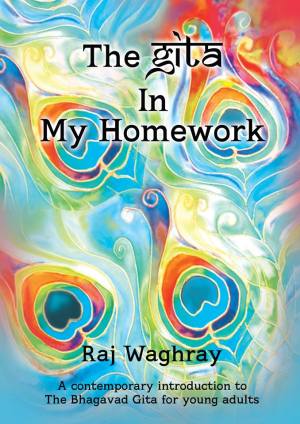Raj Waghray was kind enough to allow me a quick review of his well written book ‘The Gita in my Homework’. Though it was decided a few months back, ‘better late than never’ is a motto that never did anyone any harm. It was a swift read, and since I am also reading Easwaran’s contemporary guide to the Gita in parallel, it put things into perspective.
The Nature of Things
The crucial element of all spiritual literature is the fact that all is One. Everything that you see is nothing but a perception, an extension of your being, as perceived by you. There is no ‘me’, there is no ‘them’, it is just what exists Now in this fabric of reality.
Time is an illusion, so is the past while future is merely imagined. Thus, mindfulness (now happily preached to young CEOs through business articles) is crucial to help us stay focused on work at hand.
Gita states that even the great war Mahabharat had no clear good/bad guys. The tale is layered, and often narrated with a bias. All situations in our life play the game of perceptions, and only when you take a step back, can you analyse with a clear head.
The Lightness of Being
Since the world around us exists inside us as perceptions, all emotions (positive and negative) affect us. There is no anger towards ‘others’, there is no love towards ‘others’ because everything is ‘us’. This realisation helps us detach, because the only thing we now have to consciously observe is our thought process.
The fear that Arjun experienced on the battlefield was of no consequence, explained Krishna, as he revealed His true form. He explained that all time, all universe, all beauty and even the gargantuan mountains all exist as Him. Say what? We are all connected, we are all one. One single consciousness. You blip, the world blips, because it’s your mind.
Letting Go of ‘Me’
When you realise (easier said than done) that there is no ‘you’ and ‘them’, the ego and biases and jealousy dissolves. There is boundless joy and love for living, because your focus stays in the moment. You do your best because you have realised the Oneness. Faith in you is faith in the Supreme which is you which is me and you and them and you.
Thus Tackling Real Issues
The above highly condensed explanation of the underlying philosophy lays the foundation of what helps tackle our ‘daily issues’ in our ‘practical lives’. Because now- we consciously realise the inconsequential nature of fear, self doubt, instant gratification and biases. This helps us deal wth stress. This helps us be resilient in the battlefield of starting up. This helps us have a Krishna for an Arjun in us. Voila!
The Gita in my Homework
Raj, however, wrote the book for kids and young adults. Attempting to explain the nature of things might not be the most important of things at that age, and it is easier to explain things on the basis of good/bad, education/laziness and obedience to parents. It is wiser to make high performing kids (practical purposes) happen by offering selective advise by quoting selective lessons from Gita.
Describing lessons from a certain perspective for the time being plays its role well till the kids are old enough to explore (Raj pushes the case of ‘curiosity’ as a trait) and yearn to learn more. Why have them questioning reality at an age when their school report cards help them more? Why have them contemplate transcendence when their career paths are yet to be charted?
Raj strikes a chord with highly realistic examples and lessons, making for an easy cheerful read which has the potential to initiate curiosity regarding the Gita in these young minds. At the right age, they might choose to know more 🙂
And that’s the beauty of this conversation between Arjun and Krishna.
Quite like reality itself, it’s open to interpretation.





